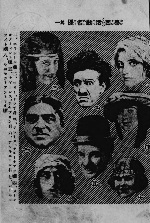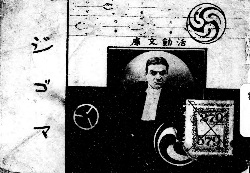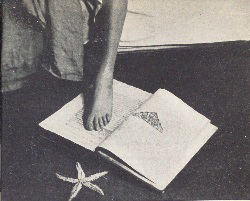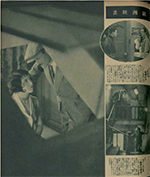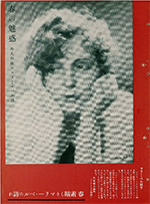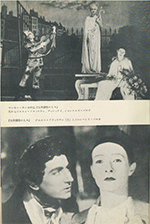![]()
Section 3: Movies
The cinematograph invented in France later evolved into silent pictures and talkies and established itself as the king of mass entertainment the world over. Japan was not an exception. For this reason, the large number of famous French movies which were imported to and released in Japan were much more numerous than other genres and this led to a large number of Japanese becoming fascinated with France from the pre to postwar periods.
First showing of cinematograph in Japan
The cinematograph was the prototype for motion pictures, and was invented by the Lumière brothers in France in 1895. Kyoto businessman INABATA Katsutaro (1862-1949) had met older brother Auguste Lumière (1862-1954) as a fellow student at a Lyon technical school, and when he travelled to France in 1896 he saw the cinematograph and acquired the promotional rights for Japan, then arranged the first showing in Japan on February 15 the following year at Osaka's Nanchi Theater. The camera man Constant Girel (1873-1952) accompanied INABATA to Japan and filmed the first cinematograph in Japan, and that film is archived in the Lumière Company Japan related film collection Meiji Japan. INABATA later transferred the promotional rights to YOKOTA Einosuke (1872-1943) which was the beginning of the Nikkatsu Corporation.
Katsudō shashin zasshi henshūkyoku, Wagahai wa firumu de aru, Katsudō shashin zasshisha, 1917 [364-140] 
A book which borrows the style of NATSUME Soseki's (1867-1916) Wagahai wa Neko de Aru with a film which discusses the movie camera as well as the principles, history and other aspects of film. The book also introduces major actors and movie companies from the time, both from Japan and overseas.
The age of silent pictures
The French movie industry continued to develop steadily under the movie companies Pathé and Gaumont. The Max Linde (1883-1925) comic films and the crime action series Zigoma, which were produced around this time, were also extremely popular in Japan. There were translated movies produced one after another of the latter in particular, including Japan Zigoma, and there were even crime cases where the criminal methods used in the films were imitated, leading to the films being banned by the authorities.
SUZUKI Motoyoshi (Tr.), Jigoma, Tomoe shoten[et al], 1912 [特100-411] ![]()
A novelization, which were printed in large quantities at that time.
In 1920's France, the dadaism and surrealism which were the trend in literature and the arts also influenced the movies, and there was a boom of avant-garde movies. Major works included, An Andalusian Dog and The Golden Age by surrealism movie titan Luis Buñuel (1900-1983). These type of avant-garde movies were introduced to Japan by critic UCHIDA Kisao (1901-1945) and others.
UCHIDA Kisao, Ōbei eigaron, Shorin juntendō, 1935 [778.23-U822o] 
UCHIDA Kisao served as an editor of the Kinema Junpō [Z11-158] at The First Higher School and later served as a movie critic for the same magazine. He was known for highly praising the early works of OZU Yasujiro (1903-1963). From 1929, UCHIDA spent 4 years traveling in Paris and New York. In Paris he viewed a number of the latest avant-garde films, including Man Ray's (1890-1976) The Sea Star, and the results of these viewings are presented in the Zen'ei eiga (lit. avant-garde film) section of the first volume of this work.
The age of talkies
Movies finally entered the age of the talkies. The first French talkie shown in Japan was Under the Roofs of Paris directed by René Clair (1898-1981) which was shown in 1931, and it is said that French literature scholar YAMANOUCHI Yoshio (1894-1973) spoke in his university classes of how he was moved to be able to directly hear the French lines spoken by the French actress in this movie.
Eiga to engei, 8(6), 1931.6, Asahi shimbunsha [雑35-66] ![]()
A movie magazine introductory article at the time of the initial release of Under the Roofs of Paris.
In talkies, the lines spoken by actors, and dialogue were added as important elements of the on-screen expression. In France, with its long history of literature and theater traditions, this led to a strengthening of literature- and theater-like elements in movies, and the works which were backed by a deep insight into the subtleties of life and what it is to be human, and the film expression techniques used for such, came to be known as "poetic realism". French film entered a golden ages in the 1930's, revolving around the 4 great masters who embodied this poetic realism, René Clair, Jean Renoir (1894-1979), Julien Duvivier (1896-1967) and Jacques Feyder (1885-1948).
Even in Japan, these various works were widely appreciated by not just film related individuals and intellectuals, but also by the general public. For example, in the annual best 10 lists from 1931 to 1939 compiled from critic votes in Kinema Junpō [Z11-158], the number 1 or 2 spot was always a French film (specifically the works of Clair, Feyder and Duvivier) every year (French films took the number 2 spot in 1931 and 1933 and the number 1 spot every other year).
In addition, the inserted songs in the above-mentioned Under the Roofs of Paris touched off the popularity of chanson within Japan. The film July14 by the same director, released in 1933, was given the Japanese title Pari Sai (lit. Paris Day) and as a result of that Japanese title, the July 14th national Day is still known as "Pari Sai" even today in Japan. It is said that Clair, who later came to Japan for the Japan World Exposition, was surprised when he heard the origin of the phrase "Pari Sai" from Tohotowa's KAWAKITA Nagamasa (1903-1981). In addition, the novelist IKENAMI Shotaro (1923-1990) from Tokyo's downtown saw this movie when he was a child, and wrote that he felt a strong affinity for the human nature of downtown Paris which was captured in the film.
If the first half of the 1930's was Clair's time, then the second half could be said to have belonged to Feyder and Duvivier. It is said that the background to the pessimism and nihilism seen in their works so capturing the hearts of the Japanese was due to the similar situations in France and Japan, with the global economic downturn after the Great Depression in 1929, the rise of fascism and anxiety about war.
Marie Bell (1900-1985) (Kinema shūhō (233), 1935.3 [Z11-1848] ) ![]()
She played a double role in Feyder's Le grand jeu, playing both the main character's lover and a barmaid. Thereafter, in Duvivier's Un carnet de bal, which was released in Japan in 1938, she played an elegant widow, and mesmerized Japanese fans. Other popular actors at the time included the cute Annabella (1907-1996), the handsome actor Charles Boyer (1899-1978), and Jean Gabin (1904-1976), who remained great both before and after the war.
The influence of France on Japanese films during this time was immeasurable not only for the film people from the same era, but also on the younger film people who would take part in the film industry after the war. It can be said that this was a peak in fascination and empathy with France achieved through film.
French films after the war
After the war, the movie industry again entered a period of prosperity. The French films released during this period were not only the most recent works, but also the famous works that were banned in Japan before the war, and these works along with American, Italian and other films drove the popularity of Western movies.
Film works from before and during the war which were released in Japan after the war included La fin du jour by Duvivier in 1948, and in the following year Grand Illusion (at that time, however, the cut version edited by the military authorities during the war was released) by Jean Renoir, who was one of the four great masters, but before the war whose works had not been widely introduced in Japan excluding The Lower Depths, etc., and in 1952, Children of Paradise, a major work by Marcel Carné (1906-1996), who belonged to the generation after the 4 greater masters.
The industry was prosperous and a number of works from after the war were also released, including poet Jean Cocteau (1889-1963) directed Beauty and the Beast, René Clément's (1913-1996) The Damned and Forbidden Games, and Henri-Georges Clouzot's (1907-1977) Manon and The Wages of Fear.
Les enfants du Paradis (IIJIMA Tadashi, Kon’nichi no Furansu eiga, Hakusuisha, 1952 [778.25-I193k] )![]()
A masterpiece of poetic realism film, lasting over 3 hours and directed by Marcel Carné. While filmed under the adverse conditions of the Nazi occupation, the film shows the resistive spirit of the French people and the potential power of French film, and the film was met with high praise and emotion in Japan as well. In addition to being selected as the number 1 work in French cinema history in France in 1979, in Japan as well, the film was selected as the number one foreign film released in Japan in the end of December 1980 issue of Kinema Junpō.
From nouvelle vague onward
In the latter half of the 1950's, a film movement called "nouvelle vague" began, which rebelled against the artistic style of previous movies such as those in the poetic realism style, and the rationale and problem presentation in this works had a major impact worldwide, including Japan. The improvisational direction methods seen in leading nouvelle vague director Jean-Luc Godard's (1930-present) Breathless and other works in particular, had a big impact on Japanese film people, etc., at the time. In Japan as well, from the 1960's onwards, a number of controversial works were released by young directors including OSHIMA Nagisa (1932-2013), YOSHIDA Yoshishige (1933-present) and SHINODA Masahiro (1931-present) and were referred to as "Shochiku nouvelle vague". There was no direct influential relationship between these works and France, however from the 1950's to the 1960's there was a worldwide movement to work towards innovation in film, and the phenomena in Japan were a part of this.
There were a large number of French film stars who became popular after the war in Japan, including Gérard Philipe (1922-1959), Brigitte Bardot (1934-present), Alain Delon (1935-present) and Catherine Deneuve (1943-present), however Alain Delon was particularly popular, and when he visited Japan for the 3rd French Film Festival in Japan in April of 1963, it drove his fans into a frenzy. His popularity has shown to be steadfast, continuing even into recent years with the Alain Delon 's 75th Anniversary Retrospective held in Tokyo and Kyoto in 2010.
After the decline of nouvelle vague, French film entered a period of stagnation. Even within Japan, they were supplanted by American films, and their presence became a shadow of what it once was, and the French Film Festival in Japan which had once invited Alain Delon, etc., was discontinued thereafter. In the 1980s, the rise of young directors including Jean-Jacques Beineix (1946-present), Luc Besson (1959-present), Leos Carax (1960-present), and popular works by other directors soon led to a resurgence in popularity which continues today. The French Film Festival in Japan was also revived in 1993 and continues to be held annually.

